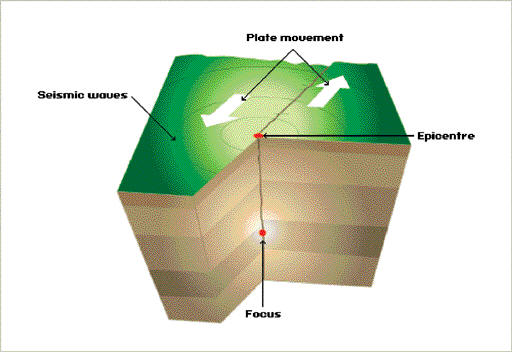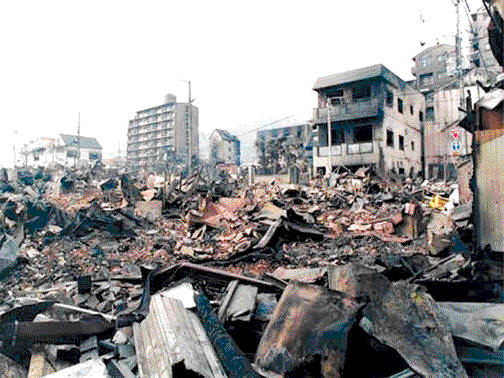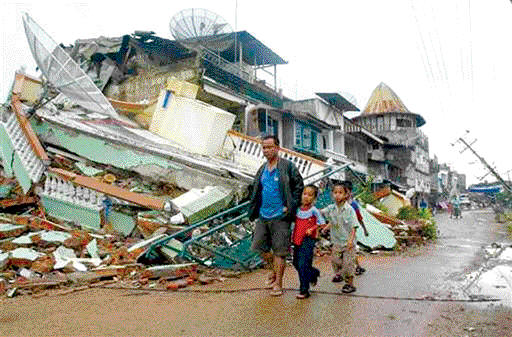 Earthquakes: Are they becoming frequent? Earthquakes: Are they becoming frequent?
Nature, despite providing all support to sustain life on Earth, has
been displaying its ruthless force every now and then to living beings,
ever since life evolved on Earth.
Among all natural calamities (disasters), an earthquake can be
considered as one of the most dangerous since it is so spontaneous
(instant), impossible to stop and there is very little you can do to get
away from it.
|

How an earthquake happens |
You are sure to know about the earthquake that shattered southern
China a few weeks back, causing more than 40,000 deaths and millions of
displacements. Therefore, let’s have a brief look at this natural
occurrence and whether there is a tendency for the number of earthquakes
to increase in the future; there is already heated discussions about
this.
Earthquakes in brief
An earthquake is basically a situation where the ground which
generally is at rest starts to shake, making nearly everything on it
unstable. But, technically speaking, this is a phenomenon which takes
place as a result of a sudden release of energy in the Earth’s crust.
This energy is released in the form of seismic waves which cause all
the havoc (destruction). Seismometers are used to measure the
intensities of these seismic waves and the Richter Scale is used to
check the severity of the earthquake.
In fact, the Richter Scale looks at the ‘moment magnitude’ of the
seismic wave. Moment magnitude defines a physical quantity which depends
on the slip on the fault and the area of the fault surface that slips.
In addition, another scale known as the ‘Mercalli Scale’ is used to
measure the intensity of shaking of the ground. Where the Richter scale
is concerned, quakes below the value 3 are almost imperceptible (too
small to be felt) and quakes greater than 7 are considered catastrophic
(devastating). The shaking in earthquakes can also trigger landslides
and occasionally volcanic activity.
How and where they form
|

Earthquake in Kobe |
Generally, earthquakes can happen at plate boundaries or sometimes,
at a certain distance from the boundary. First, let’s look at the
earthquakes at plate boundaries. You might remember what we wrote about
plate tectonics.
When the plates of the Earth move, there may be situations where they
will move past each other smoothly only if there are no irregularities
or asperities (rough features) along the boundary that would increase
the frictional resistance.
But, most boundaries do have such irregularities and this leads to a
form of stick and slip behaviour. This means, once the boundary has
locked due to friction, continued relative motion between the plates
leads to increasing stress and therefore, stores strain energy in the
volume around the fault surface which relates to the ‘sticking’.
This continues until the stress has risen sufficiently to break
through the irregularity, suddenly ‘slipping’ over the locked portion of
the fault, releasing the stored energy. This energy is released as
seismic waves, frictional heating of the fault surface, and causes an
earthquake.
But, most importantly, it is estimated that only 10 per cent or less
of an earthquake’s total energy is radiated as seismic energy. Most of
the earthquake’s energy is used to power the growth of the earthquake
fracture or is converted into heat generated by friction.
The earthquakes that happen away from plate boundaries are due to the
deformations that are spread over a larger area than plate boundaries.
Earthquakes happen when strains that get built within the faults
increase and are released at once.
The special term ‘earthquake storms’ is used for earthquakes that
occur in a cluster, where each earthquake, gets triggered by the shaking
of the previous earthquake creating a series of earthquakes.
What’s the trend?
Right now there are two ideas coming up. One suggestion is that due
to the varying pressure on the Earth caused by human constructions etc,
the tendency for earthquakes to happen can increase.
|

Earthquake in Sumatra |
Certain statistics support this by showing that the intensities of
earthquakes in regions like China have increased due to large
constructions like the Shanghai World Financial Centre and Taipei 101
which are among the tallest buildings in the world right now.
However, the other party argues that there is no real increase in
tendency, but it just seems that way due to advancements made in reading
earthquake data. Therefore, according to them, the improved data
reception has implied that there have been too many earthquakes
happening lately.
The fact that in 1931, there were only about 350 seismic stations
operating in the world and today there are more than 8,000 stations,
vouches for the second argument.
Anyway, right now it has been quite hard to predict the trends of
future earthquake patterns due to the lack of accuracy in past data, and
yet, advances in technology would surely provide much better monitoring
and prediction mechanisms in the days to come by.
-Aravinda Dassanayake |
